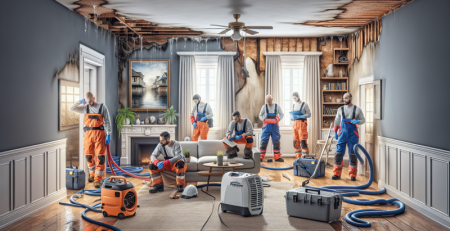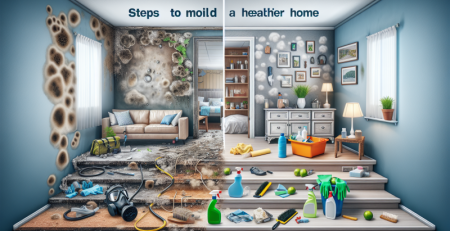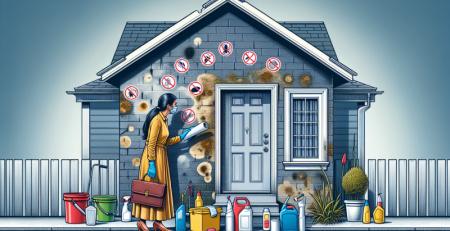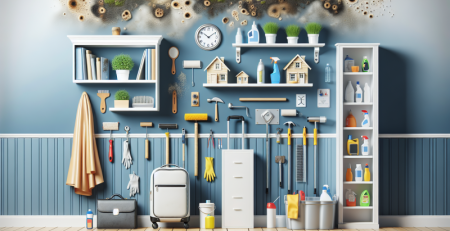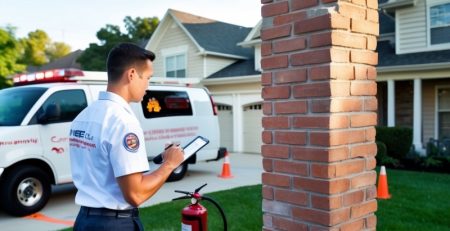How to Safeguard Your Home Against Heavy Rain
Heavy rain can pose a significant threat to your home, leading to water damage, mold growth, and costly repairs. As homeowners, it’s crucial to take proactive measures to safeguard your property against the elements. In this guide, we’ll explore effective strategies to protect your home from heavy rainfall, ensuring that you can enjoy peace of mind during stormy weather. From proper drainage systems to regular maintenance checks, we’ll cover essential tips that can help you minimize the risk of water intrusion. At Kraus Restoration, NJ’s leaders in water, mold, and fire damage restoration, we understand the importance of being prepared. Our IICRC certified experts are available 24/7 to assist you with any emergency services you may need. Serving Central and Northern NJ, we are committed to helping you keep your home safe and dry. For immediate assistance, call us at (973) 886-2021.
Assessing Your Home’s Vulnerability to Water Damage
Understanding your home’s vulnerability to water damage is crucial, especially in areas prone to heavy rain. Water damage can lead to significant structural issues, mold growth, and costly repairs. By assessing your home’s susceptibility, you can take proactive measures to safeguard your property and ensure the safety of your family.
Start by examining the exterior of your home. Look for any signs of wear and tear on the roof, gutters, and downspouts. A well-maintained roof is your first line of defense against rainwater intrusion. Check for missing shingles, cracks, or any other damage that could allow water to seep in. Ensure that your gutters are clean and free of debris, as clogged gutters can overflow and direct water toward your foundation. Downspouts should direct water at least six feet away from your home to prevent pooling around the foundation.
Next, assess your home’s grading and drainage systems. The landscape around your home should slope away from the foundation to facilitate proper drainage. If you notice any low spots where water tends to accumulate, consider regrading the area or installing a French drain to redirect water away from your home. Proper drainage is essential in preventing water from seeping into your basement or crawl space.
Inspect your windows and doors for any gaps or cracks that could allow water to enter. Weather stripping and caulking can help seal these openings and prevent leaks during heavy rain. Additionally, consider installing window wells with covers for basement windows to keep rainwater out.
Another critical area to evaluate is your basement or crawl space. These areas are particularly vulnerable to water damage. Check for any signs of moisture, such as dampness, mold, or mildew. If you find any issues, it may be necessary to invest in waterproofing solutions, such as sump pumps or interior drainage systems. According to the American Society of Home Inspectors, about 60% of homes have some form of moisture problem in their basements, making it essential to address these vulnerabilities.
Additionally, consider the materials used in your home’s construction. Homes built with water-resistant materials are less susceptible to damage. If you are planning renovations, opt for materials that can withstand moisture, such as fiber-cement siding or waterproof flooring options.
It is also wise to review your home insurance policy to understand your coverage for water damage. Many standard policies do not cover flood damage, so if you live in a flood-prone area, you may need to purchase additional flood insurance. The Federal Emergency Management Agency (FEMA) provides resources to help homeowners understand their flood risk and insurance options.
Regular maintenance is key to preventing water damage. Create a seasonal checklist to inspect your home’s exterior, gutters, and drainage systems. By staying proactive, you can identify potential issues before they escalate into costly repairs.
In addition to these assessments, consider consulting with professionals who specialize in water damage prevention and restoration. They can provide valuable insights and recommendations tailored to your specific home and location. For example, a professional inspection can uncover hidden vulnerabilities that you may not notice during a casual assessment.
In conclusion, assessing your home’s vulnerability to water damage is a vital step in safeguarding your property against heavy rain. By taking the time to evaluate your home’s exterior, drainage systems, and potential entry points for water, you can implement effective strategies to protect your home. Remember, prevention is always more cost-effective than dealing with the aftermath of water damage. For more information on how to protect your home, visit our about page or explore our services for professional assistance. If you have any questions or need help, feel free to contact us.
Essential Gutter Maintenance Tips
Maintaining your gutters is a crucial aspect of protecting your home from the damaging effects of heavy rain. Proper gutter maintenance ensures that rainwater is effectively channeled away from your home’s foundation, preventing water damage, mold growth, and structural issues. Here are some essential tips to keep your gutters in top condition and safeguard your home against heavy rainfall.
First and foremost, regular inspections are vital. At least twice a year, ideally in the spring and fall, take the time to inspect your gutters for any signs of wear and tear. Look for cracks, rust, or loose connections that could lead to leaks. Additionally, check for any blockages caused by leaves, twigs, or other debris that can prevent water from flowing freely. If you notice any issues during your inspection, address them promptly to avoid more significant problems down the line.
Cleaning your gutters is another essential maintenance task. Clogged gutters can lead to overflowing, which can damage your roof, siding, and foundation. Use a sturdy ladder to access your gutters safely, and wear gloves to protect your hands from sharp debris. Remove any leaves, dirt, or other obstructions, and consider using a garden hose to flush out the gutters and downspouts. This will help ensure that water flows smoothly and that your gutters are functioning correctly. If you prefer, you can also hire professionals who specialize in gutter cleaning to handle this task for you.
In addition to cleaning, it is essential to check the downspouts. Ensure that they are clear and directing water away from your home’s foundation. Downspouts should extend at least three to four feet away from the base of your home to prevent water from pooling near the foundation, which can lead to serious structural issues. If your downspouts are not directing water far enough away, consider adding extensions or splash blocks to help channel the water away effectively.
Another important aspect of gutter maintenance is ensuring that your gutters are properly pitched. Gutters should slope slightly toward the downspouts to facilitate proper drainage. If you notice that water is pooling in certain areas of your gutters, it may be necessary to adjust the pitch. This can often be done by adjusting the hangers that hold the gutters in place. A slight slope of about a quarter inch for every ten feet of gutter is generally recommended.
Installing gutter guards can also be a wise investment for homeowners looking to reduce maintenance efforts. Gutter guards help keep debris out of your gutters, minimizing the frequency of cleanings. While they do not eliminate the need for maintenance entirely, they can significantly reduce the amount of debris that accumulates, making it easier to keep your gutters functioning properly.
If you live in an area prone to heavy rainfall, consider scheduling a professional gutter inspection and cleaning before the rainy season begins. Professionals can identify potential issues that may not be immediately visible and can provide solutions to ensure your gutters are ready to handle the downpour. Regular maintenance not only protects your home but can also extend the lifespan of your gutters.
Finally, be mindful of the surrounding landscape. Trees and shrubs can contribute to gutter debris, so consider trimming back any overhanging branches that may drop leaves or twigs into your gutters. Additionally, ensure that your landscaping directs water away from your home. Proper grading and drainage around your property can help prevent water from pooling near your foundation, further safeguarding your home against heavy rain.
In conclusion, maintaining your gutters is a critical step in protecting your home from the damaging effects of heavy rain. By regularly inspecting, cleaning, and ensuring proper drainage, you can prevent costly repairs and keep your home safe and dry. For more information on how to protect your home from water damage, visit our residential design page or reach out through our contact page for expert assistance. Taking these proactive steps will help you safeguard your home and ensure that it remains a safe haven during heavy rainstorms.
Landscaping Strategies to Redirect Rainwater
When heavy rain strikes, it can pose significant risks to your home, leading to flooding, water damage, and even structural issues. One effective way to safeguard your property is through strategic landscaping that redirects rainwater away from your foundation. Implementing these landscaping strategies not only protects your home but also enhances the overall aesthetic of your outdoor space.
The first step in redirecting rainwater is to assess your property’s topography. Understanding how water naturally flows across your land is crucial. Look for low spots where water tends to accumulate and high points where water can be diverted. Creating a sloped landscape can help channel rainwater away from your home. This can be achieved by grading your yard so that it slopes away from the foundation, ensuring that rainwater flows toward designated drainage areas rather than pooling near your house.
Another effective strategy is to incorporate rain gardens into your landscaping. A rain garden is a planted depression that allows rainwater runoff from impervious surfaces like roofs, driveways, and sidewalks to be absorbed. These gardens are typically filled with native plants that thrive in wet conditions, making them both functional and beautiful. By capturing and filtering rainwater, rain gardens can significantly reduce runoff and prevent erosion, while also providing a habitat for local wildlife. For more information on how to create a rain garden, you can visit our residential design page.
Additionally, installing permeable paving in driveways and walkways can help manage rainwater effectively. Unlike traditional concrete or asphalt, permeable paving allows water to seep through the surface and into the ground below, reducing runoff and minimizing the risk of flooding. This type of paving can be made from various materials, including porous concrete, permeable pavers, or gravel. By incorporating permeable surfaces into your landscaping, you can enhance water absorption and promote healthier soil.
Another landscaping strategy involves the use of swales, which are shallow, vegetated channels designed to direct water runoff. Swales can be strategically placed to guide rainwater away from your home and into areas where it can be absorbed or redirected to a drainage system. By planting native grasses and other vegetation in these swales, you can enhance their effectiveness while also adding beauty to your landscape. Swales not only help manage rainwater but also improve water quality by filtering pollutants before they reach larger bodies of water.
Incorporating trees and shrubs into your landscape can also play a vital role in managing rainwater. The root systems of these plants help to absorb excess water, reducing runoff and promoting groundwater recharge. Additionally, trees provide shade, which can help reduce evaporation and keep your landscape healthy during dry spells. When selecting plants, consider native species that are well-adapted to your local climate and soil conditions, as they will require less maintenance and water.
Finally, it is essential to maintain your landscaping to ensure its effectiveness in redirecting rainwater. Regularly check and clear gutters, downspouts, and drainage systems to prevent blockages that could lead to water pooling around your home. Additionally, monitor your landscaping for any signs of erosion or damage, and make necessary adjustments to maintain proper drainage.
By implementing these landscaping strategies, you can effectively redirect rainwater and protect your home from the damaging effects of heavy rain. Not only will these methods safeguard your property, but they will also enhance the beauty and functionality of your outdoor space. For more tips on protecting your home from water damage, visit our water cleanup services page. If you have any questions or need assistance with your landscaping projects, feel free to contact us for expert guidance.
Installing Effective Drainage Systems
When it comes to safeguarding your home against heavy rain, one of the most critical steps is to install an effective drainage system. A well-designed drainage system can prevent water accumulation around your property, which can lead to serious structural damage, mold growth, and other costly issues. The first step in creating an effective drainage system is to assess your property’s landscape and identify areas where water tends to pool. This could include low-lying areas, around the foundation, or near driveways and sidewalks. Once you have identified these areas, you can choose the appropriate drainage solutions to mitigate the risk of flooding.
One common solution is the installation of gutters and downspouts. Gutters collect rainwater from the roof and channel it away from the foundation of your home. It is essential to ensure that your gutters are clean and free of debris to function effectively. Downspouts should direct water at least five to ten feet away from the foundation to prevent water from seeping into the basement or crawl space. Additionally, consider adding extensions to your downspouts to further divert water away from your home.
Another effective drainage solution is the use of French drains. A French drain consists of a trench filled with gravel or rock that contains a perforated pipe. This system collects excess water and redirects it away from your property. French drains are particularly useful in areas with poor drainage or where water tends to accumulate. They can be installed around the perimeter of your home or in specific problem areas to help manage water flow.
In addition to gutters and French drains, you may also want to consider installing a sump pump. A sump pump is a device that is placed in the lowest part of your basement or crawl space to remove accumulated water. When heavy rain occurs, the sump pump activates and pumps water out of the home, preventing flooding and water damage. It is crucial to ensure that your sump pump is functioning correctly and to have a backup power source in case of a power outage during a storm.
Another important aspect of an effective drainage system is the grading of your landscape. The ground should slope away from your home to facilitate proper water runoff. If your yard is flat or slopes towards your home, you may need to regrade the landscape to create a slope that directs water away from the foundation. This can be achieved by adding soil to create a berm or by installing retaining walls to manage water flow.
Moreover, permeable paving is an innovative solution that can help manage rainwater runoff. Unlike traditional paving materials, permeable paving allows water to seep through the surface and into the ground below. This reduces the amount of surface runoff and helps recharge groundwater supplies. Consider using permeable pavers for driveways, patios, and walkways to enhance your drainage system.
Regular maintenance of your drainage system is essential to ensure its effectiveness. Inspect gutters, downspouts, and drains regularly for clogs and debris. Clean them out as needed to prevent blockages that can lead to overflow and water damage. Additionally, check for any signs of erosion or settling in your landscape that may affect the grading and drainage of your property.
If you are unsure about how to install an effective drainage system or need assistance with maintenance, it may be beneficial to consult with professionals who specialize in water management solutions. They can provide expert advice and services tailored to your specific needs. For more information about our services, visit our services page.
In conclusion, installing an effective drainage system is a vital step in protecting your home from the damaging effects of heavy rain. By implementing solutions such as gutters, French drains, sump pumps, and proper grading, you can significantly reduce the risk of water damage and ensure the longevity of your property. Regular maintenance and professional assistance can further enhance the effectiveness of your drainage system, providing peace of mind during stormy weather. For more insights on safeguarding your home, feel free to reach out through our contact page.
Waterproofing Your Home’s Foundation
Waterproofing your home’s foundation is a critical step in protecting your property from the damaging effects of heavy rain. When rainwater accumulates around your foundation, it can lead to serious issues such as water intrusion, mold growth, and structural damage. To effectively safeguard your home, it is essential to implement a comprehensive waterproofing strategy that addresses potential vulnerabilities in your foundation.
The first step in waterproofing your foundation is to assess the current condition of your property. Look for signs of water damage, such as damp spots in the basement, peeling paint, or mold growth. These indicators can help you identify areas that require immediate attention. Additionally, check the grading around your home. The ground should slope away from the foundation to facilitate proper drainage. If the grading is inadequate, consider regrading the landscape to direct water away from your home.
Next, inspect your gutters and downspouts. Clogged gutters can overflow, allowing water to pool near your foundation. Ensure that your gutters are clean and functioning properly. Downspouts should extend at least six feet away from the foundation to prevent water from seeping into the soil around your home. Installing downspout extensions can be an effective solution to this problem.
Another important aspect of waterproofing is the application of a waterproof sealant to your foundation walls. This sealant acts as a barrier against moisture, preventing water from penetrating through cracks and porous surfaces. Before applying the sealant, clean the foundation walls thoroughly to remove any dirt, debris, or existing paint. Once the surface is prepared, apply the sealant according to the manufacturer’s instructions, ensuring complete coverage for maximum protection.
In addition to sealants, consider installing a drainage system around your foundation. French drains or perimeter drains can effectively redirect water away from your home. These systems collect water that accumulates near the foundation and channel it away, reducing the risk of water intrusion. If you live in an area prone to heavy rainfall, investing in a sump pump can also be beneficial. A sump pump removes excess water from your basement or crawl space, preventing flooding and water damage.
It is also essential to regularly maintain your waterproofing measures. Inspect your foundation and drainage systems periodically to ensure they are functioning correctly. Look for any signs of wear or damage, and address any issues promptly to prevent further complications. If you notice persistent water problems, it may be wise to consult a professional for a thorough evaluation and potential remediation.
In conclusion, waterproofing your home’s foundation is a vital component of safeguarding your property against heavy rain. By assessing your current situation, maintaining proper drainage, applying waterproof sealants, and installing effective drainage systems, you can significantly reduce the risk of water damage. For more information on how to protect your home from water-related issues, consider exploring our services or contacting us for expert advice. Taking proactive steps now can save you from costly repairs in the future and ensure your home remains a safe and comfortable environment.
Preparing Your Roof for Heavy Rainfall
Heavy rainfall can pose significant risks to your home, particularly when it comes to your roof. Preparing your roof for such weather events is crucial to ensure the safety and integrity of your home. The first step in this preparation is to conduct a thorough inspection of your roof. Look for any signs of damage, such as missing shingles, cracks, or sagging areas. These issues can lead to leaks and water damage during heavy rainfall. If you notice any problems, it is advisable to contact a professional roofing service to address these concerns promptly.
Next, clear your gutters and downspouts of any debris. Clogged gutters can prevent water from flowing away from your roof and foundation, leading to potential flooding and water damage. Regular maintenance of your gutters is essential, especially before the rainy season. Ensure that downspouts direct water at least three to four feet away from your home’s foundation to minimize the risk of water pooling around your property.
Additionally, consider applying a waterproof sealant to your roof, especially if it is older or has not been treated in a while. This can help protect against leaks and prolong the life of your roofing materials. If your roof is flat, ensure that it has proper drainage systems in place to handle heavy rainfall. Flat roofs can accumulate water, leading to leaks and structural damage if not adequately managed.
Inspect the flashing around chimneys, vents, and skylights, as these areas are often vulnerable to leaks. Ensure that the flashing is intact and properly sealed. If you find any gaps or damage, repair or replace the flashing to prevent water intrusion. It is also wise to check the condition of your attic insulation and ventilation. Proper ventilation helps regulate temperature and moisture levels, reducing the risk of mold growth and structural damage.
If you live in an area prone to severe storms, consider investing in a roof with enhanced durability features. Some roofing materials are specifically designed to withstand heavy rain and wind, providing better protection for your home. Consult with a roofing professional to explore options that suit your home’s needs.
In addition to these preparations, it is essential to have an emergency plan in place. Familiarize yourself with the location of your main water shut-off valve and ensure that your family knows how to access it in case of flooding. Keep important documents and valuables in a safe, elevated location to protect them from potential water damage.
Finally, stay informed about weather forecasts and alerts. Being proactive and aware of impending storms can help you take necessary precautions in advance. If heavy rainfall is predicted, consider taking additional measures such as moving outdoor furniture and equipment indoors to prevent damage.
By taking these steps to prepare your roof for heavy rainfall, you can significantly reduce the risk of water damage and ensure the safety of your home. For more information on safeguarding your home against heavy rain and other related services, visit our services or learn more about us. If you experience any water damage after a storm, do not hesitate to reach out through our contact page for assistance.
Creating an Emergency Plan for Severe Weather
When preparing for severe weather, particularly heavy rain, having a well-structured emergency plan is essential for ensuring the safety of your family and the protection of your home. An effective emergency plan should address various aspects, including communication, evacuation routes, and resource management. Start by gathering your family and discussing the potential risks associated with heavy rain, such as flooding, power outages, and property damage. Make sure everyone understands the importance of staying informed about weather updates through reliable sources like local news or weather apps.
Next, establish a communication plan. Designate a meeting place where your family can regroup in case you become separated during an emergency. This location should be easily accessible and known to all family members. Additionally, ensure that everyone has a list of emergency contacts, including local authorities, neighbors, and family members who live outside the immediate area. This will help you stay connected and informed during a crisis.
It is also crucial to identify and plan for evacuation routes. Research the safest paths to higher ground or emergency shelters in your area. Familiarize your family with these routes and practice them if possible. Keep in mind that some roads may become impassable during heavy rain, so having multiple routes planned can be beneficial.
Incorporate a resource management strategy into your emergency plan. This includes preparing an emergency kit stocked with essential supplies such as water, non-perishable food, flashlights, batteries, a first-aid kit, and any necessary medications. Store these items in a waterproof container and ensure that everyone knows where to find them. Additionally, consider having a battery-operated radio to receive weather updates and alerts, especially if power outages occur.
Another critical aspect of your emergency plan is to safeguard your home against potential water damage. Inspect your property for vulnerabilities, such as clogged gutters, inadequate drainage systems, or cracks in the foundation. Taking proactive measures to address these issues can significantly reduce the risk of flooding. If you need assistance with water damage prevention or cleanup, consider reaching out to professionals who specialize in water cleanup services.
Furthermore, ensure that your insurance policies are up to date and cover potential flood damage. Review your coverage options and consider additional flood insurance if you live in a high-risk area. Having the right insurance can provide peace of mind and financial protection in the event of severe weather-related damage.
Lastly, educate your family about the signs of severe weather and the appropriate actions to take. This knowledge can empower everyone to respond quickly and effectively when a storm approaches. Encourage open communication about any concerns or questions regarding the emergency plan, and make adjustments as necessary to ensure that everyone feels prepared and safe.
In summary, creating an emergency plan for severe weather is a vital step in safeguarding your home and loved ones against the impacts of heavy rain. By establishing clear communication channels, planning evacuation routes, managing resources, and addressing potential vulnerabilities in your home, you can significantly enhance your preparedness for severe weather events. For more information on how to protect your home and family during heavy rain, consider exploring our services or contact us for expert advice and assistance.
In conclusion, safeguarding your home against heavy rain is essential for protecting your property and ensuring the safety of your loved ones. By taking proactive measures such as inspecting and maintaining your gutters, sealing windows and doors, and creating proper drainage systems, you can significantly reduce the risk of water damage. Additionally, investing in flood barriers and ensuring your landscaping directs water away from your home can provide an extra layer of protection. Remember, preparation is key—by implementing these strategies well before the rainy season, you can enjoy peace of mind knowing that your home is equipped to withstand the elements. Stay informed, stay prepared, and take action today to keep your home safe and dry during heavy rain.


